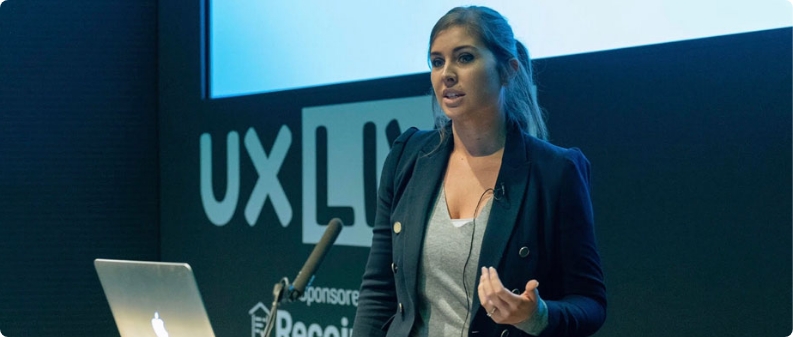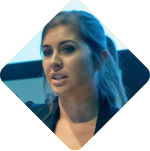
User Research Evangelist at News UK, Claire Dracott tells us about the importance of bringing the User into the heart of the business.
Hi Claire, thanks for chatting with us today. Could you tell us about News UK and what you do there?
News UK is the publication for The Sun, The Times and The Sunday Times and Wireless. Working across some of the most recognised media brands within the UK, my role as Head of User Experience and Design is to oversee all of our digital products ensuring we’re creating intuitive and beautiful experiences. I lead the team who are the go between the business and the users. We’re in constant contact with our customers to get a deeper understanding of their wants and needs and regularly transcribe that back to the business to understand what we should be working on and how we can continue improving the products.
Can you tell us a little bit about how you built the culture of user research into the Times and why you felt it was necessary?
When I first joined News UK, the user wasn’t at the heart of everything we did and the team would rarely speak with customers, essentially meaning we were designing just from our assumptions. I knew we needed to shift how we worked so as a UX&D team we changed our process to accommodate various methodologies and still work in an agile environment. The hard but crucial part was building awareness of these new ways of working with all our stakeholders throughout the business. This was a considerable part of my role for a while to really ensure the process was embedded and we were explaining the what, how and why to the business as much as we could. At times we felt like broken records, but we’re now lucky enough to have the backing of the stakeholders.
How do you use user research to iterate and develop your products?
We use various methodologies to test but the constant is the days in which we test. We decided in order to embed this successfully into our process in a big organisation we needed to set aside days every month where we get customers in the building for user research. We introduced a new initiative called ‘Testing Tuesday’ which allows us to have this regular scheduled day so we can take on-board the findings, iterate and continuously test. These full days of testing might take the form of interviews, usability tests or even more of a workshop. The main reason for scheduling these in was so the business was more aware of when research was taking place and we could get more people involved and actually streaming in to listen to the sessions.
What different research methods do you use?
We’ve got a few. We have a remote usability testing tool called UserZoom, which allows us to run various studies (card sorts, click tests, moderated usability, unmoderated usability, etc). This is a tool we use frequently within the team in conjunction with our face to face studies. The main benefits are that it’s really quick, you can throw a test out and get results back within the same day. It also allows us to have that geographical spread that we really need in order to reach all of our customers.
We then have the face to face usability tests that we run every week. This is where we get a buzz around the business with people listening in and hearing what the customer has to say. We also run longitudinal studies to really understand customer behaviours.
What do the face to face interviews give you that other methods don’t?
I find face to face interviews a lot more detailed. Even if you come up with a script, you can really get to know that person on a different level. It helps us better understand our audiences and allows us to keep developing our personas in which we share around the business. These personas are recognised within the team as a living document that we keep adding to over time. The more customers we meet face to face, the better the overall picture we get of that person. I think this methodology also allows you to be a lot more detailed with what you’re asking. You can change questions based on what happens in the session, allowing flexibility to deep dive and really prod around the questions that you need answered. You also get a lot more of a feel from a motive point of view and can better understand what they’re feeling in relation to the brand. I really love the face to face sessions and meeting the customers who are using our products.
Have you got any favourite UX tools that you couldn’t do your job without?
Yep, we have a suite of tools we use on a regular basis. Sketch is used for all of our concepting, which allows us to easily share files and work collaboratively. With prototyping tools we’re slightly more flexible as I think it very much depends on the fidelity or type of interactions you need to portray in the prototype.
Do you ever have any concern about sharing new concepts outside the business?

Not really, if there was anything we were working on that couldn’t be shown to the public before a certain date we would run face to face sessions and get participants to sign NDAs. We might also design a separate white label so we could continue testing and iterating on the idea.
Do you get the same people over and over for testing or do you make it a point to always have fresh faces?
We always make it a point to have different people. You want to hear from a wider audience and also get a different take. As always, it depends on the methodology but we aim to get around 6 people for face to face testing so it’s achievable to get fresh faces.
What user research methods do you use across brands?
We use the same methods and have the same process throughout the UX&D team; face to face, remote and longitudinal studies are run across all of our titles. The publications differ so much – different audiences, different revenue streams, tone of voice, brand and so on. Everything’s completely different but what we find is that when it comes to UX, a lot of best practice and research patterns can be shared within the team.
Why should companies invest the time in creating customer personas?
I think from a UX and Design point of view, it’s so important to keep the customer at the heart of everything. I feel when you’re designing solutions you need to be continuously thinking about who the customer is. Personas also help the business understand our customers further by bringing them more to life.
I see personas as always being a work in progress. You’re not going to do them first time and say it’s done. These are customers who will undoubtedly change over time. You could start segmenting your audience, speaking to people and understanding what they’re like. These should be living documents that are developed based on behaviours you learn through qualitative and quantitative research methods.
How do you manage to integrate user research into product development cycles?
This is something that we initially found quite challenging. The main issue being that it was previously an ad-hoc initiative that we would do as and when something was ready to test.

The issue is that you have dependencies within the business and not everyone works in an agile environment nor to the same deadlines hence delays and the process not working as seamlessly as hoped. This is why we’ve introduced ‘Testing Tuesday’ so that testing now has some form of structure. While the process is a lot more rigid, it’s necessary. People know exactly when the testing is taking place and everyone works towards that one day.
What do you think are your biggest challenges in the next 12 months?
The main challenge I think will probably be to make sure that the teams are working on the right things. Making sure we’re validating ideas and product enhancements and feeding these into the roadmaps in order to ensure we’re really developing the products as much as we should be. Another thing that I’m keen for myself and the team to do is really keep on top of all these new technologies. Things are moving incredibly quickly in that space so we need to ensure we’re aware and utilising what’s needed to push our experiences forward.
How could you use customer data to improve your products?
Companies like Netflix are using data really well. They can surface the films your interested in, show the most appealing images to entice you to click through and even play around with time of day and the length of the show/film they might surface to you. They’ve learned about the users and obviously this is then reflected in how they show the content. It comes back to us as a company to say we should be doing a better job of knowing what people have been reading, what their interests are and really pushing the boundaries to make sure that they’re staying on site and engaged.
What’s the most valuable lesson you’ve learned at News UK?
I’d probably say the most valuable lesson I’ve learnt is to be patient and work very hard.

For years I was pushing the concept of testing and the importance of the user. It took a while and there were times where I felt I was repeating myself over and over. However, being patient about something you’re really passionate about eventually pays off. If you know it’s going to make a difference you just need to give it the time it deserves.
Do you encounter any resistance to user research? How do you counter it if you do?
We’ve been successfully testing now for about 5 years without resistance. The company are always thinking about the users and it’s an expectation from all our stakeholders that our concepts are tested. The business are engaged and will often ask what was being tested and are keen to hear the findings. However, before we had gone through the process of embedding research into the business we definitely had some resistance and skepticism, particularly around the amount of people we’d test with. I’d frequently hear “Only 6 users…”. The key here was to explain for usability tests that it’s the correct number of participants and the fact that 85% of all the usability patterns would be fleshed out with this amount. It’s something that becomes slightly repetitive but it eventually works. I had a slide in our findings deck which we would always re-use to preempt the inevitable question!
What piece of work are you most proud of at News UK, and why is that?
If I had to choose something, I’d probably choose the redesign of the smartphone apps, across both brands. Both projects were quite extensive but really allowed us to understand what was needed and test frequently. The testing and validation has paid off by seeing positive data and reviews.
With regards to the apps, what did you first start testing?
We always start with low fidelity designs and to begin with the main focus is on navigation. We did a lot of card sorting to understand what the Information Architecture (IA) may be and this then helped shape the navigation.
What will you tell companies that want to start testing but then feel like the they may not have the budget or that the costs seem too high?
I would say to start small and prove out the benefits first. Guerrilla testing could be used as a cheap method to ensure you’re getting some kind of feedback and not designing blind. The findings you get back will help shape what’s needed to go through to build and ensure customers can use it intuitively.
Are there any examples of UX that you look at and think they’ve totally nailed it?
This is really hard because it’s subjective. One of my favourite apps is Airbnb. I think from the moment you download the app the proposition and tone of voice is clear. It’s very easy to use and I love the brand principles. Another app that I really like from a design perspective is Entale, an audio app. I think they’ve done a really nice job visually despite it not being the main need of the user.
Where do you want to go next with everything?
I still think there’s quite a long way we can go. I’m really keen to start understanding behaviours in our users’ natural environments. We should hopefully start driving this forward in the next year by introducing ethnographic studies into our workflow.
